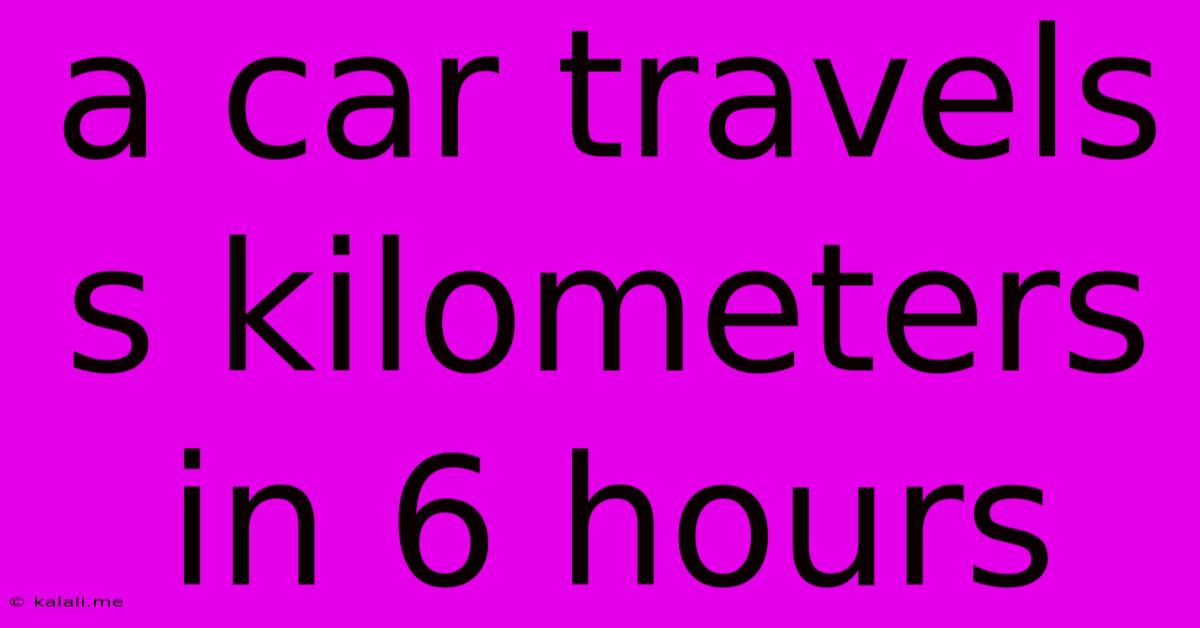A Car Travels S Kilometers In 6 Hours
Kalali
Jun 15, 2025 · 2 min read

Table of Contents
A Car Travels S Kilometers in 6 Hours: Understanding Speed, Distance, and Time
This article explores the relationship between speed, distance, and time, using the example of a car traveling s kilometers in 6 hours. We'll delve into calculating average speed, examining the impact of varying speeds, and considering real-world applications of this fundamental concept in physics. This information is crucial for understanding basic kinematics and solving related problems.
Understanding the Fundamentals: Speed, Distance, and Time
The core relationship between speed, distance, and time is expressed by the simple formula:
Speed = Distance / Time
In our scenario, the distance (s) is given in kilometers, and the time is 6 hours. Therefore, the average speed of the car can be calculated as:
Average Speed = s km / 6 hours
This formula provides the average speed over the entire 6-hour journey. It's important to note that this doesn't account for variations in speed during the journey; the car may have traveled faster at some points and slower at others. The calculated speed represents the constant speed the car would need to maintain to cover the same distance in the same time.
Calculating Average Speed for Different Distances
Let's illustrate with some examples:
- If s = 300 km: Average Speed = 300 km / 6 hours = 50 km/hour
- If s = 180 km: Average Speed = 180 km / 6 hours = 30 km/hour
- If s = 60 km: Average Speed = 60 km / 6 hours = 10 km/hour
These examples demonstrate how the average speed changes directly with the distance covered. A greater distance traveled in the same time results in a higher average speed.
Factors Affecting Speed and Considerations for Real-World Applications
While the simple formula provides a useful calculation, real-world driving involves numerous factors that impact speed:
- Traffic conditions: Congestion can significantly reduce speed.
- Road conditions: Poor road surfaces or construction can necessitate slower speeds.
- Weather conditions: Rain, snow, or fog can reduce visibility and necessitate lower speeds for safety.
- Terrain: Hill climbs and descents can influence speed.
- Vehicle limitations: The car's maximum speed and engine performance affect achievable speeds.
Therefore, the calculated average speed often serves as a theoretical value, providing a general understanding of the journey's pace rather than a precise representation of the car's speed at any given moment.
Applications and Further Exploration
Understanding the relationship between speed, distance, and time is fundamental to numerous applications, including:
- Route planning: Estimating travel time based on distance and expected average speed.
- Logistics and transportation: Optimizing delivery routes and schedules.
- Physics and engineering: Calculating velocity and acceleration in more complex scenarios.
This basic concept forms the foundation for more advanced calculations in kinematics, and a deeper exploration will unlock further insights into motion and its various aspects. Understanding these fundamentals is vital for comprehending numerous real-world phenomena.
Latest Posts
Latest Posts
-
Which Of The Following Is Viscoelastic In Nature
Jun 15, 2025
-
Differentiate Between Physical Geography And Human Geography
Jun 15, 2025
-
A Device That Converts Mechanical Energy Into Electrical Energy
Jun 15, 2025
-
Florida Atlantic University Acceptance Rate Out Of State
Jun 15, 2025
-
Diodes Are Used In Electrical Power Supply Circuits Primarily As
Jun 15, 2025
Related Post
Thank you for visiting our website which covers about A Car Travels S Kilometers In 6 Hours . We hope the information provided has been useful to you. Feel free to contact us if you have any questions or need further assistance. See you next time and don't miss to bookmark.